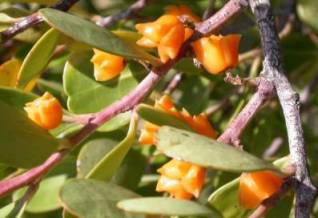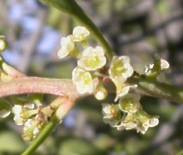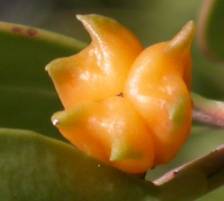Pterocelastrus tricuspidatus
Pterocelastrus tricuspidatus (Lam.) Sond.
Family: Celastraceae
Common names: candlewood, cherrywood (English), kershout, kersiehout, rooikersiehout, witpeer, witpeerhout (Afrikaans), iBholo, iTywina, uTwina (isiXhosa).
SA Tree No: 409
Introduction
When in fruit this widely distributed, evergreen bush or tree is a lovely sight, decorated with masses of brilliant orange fruit, which are enjoyed by Rock Pigeons, Mousebirds and other fruit-eating birds.

Description
Description
This is a very variable tree or shrub depending on habitat. In forests it may reach 20m with a straight trunk, on forest margins it is often a low spreading tree and in an open situation or in coastal scrub it grows as a fairly dense bush.

The colour of the leaves is also variable being yellow-green to blue-green or dark and glossy. The hard leathery leaves themselves may vary from short, broad and egg-shaped to long and slender and may have leaf stalks of short to medium length. Usually the tips are rounded, sometimes with a notch, or may be blunt or pointed, with flat or rolled margins that are thickened. The veins and midrib are more prominent on the lower, paler surface than the glossy upper surface. When bent the adult leaves snap completely and audibly which is a helpful way of confirming identification.
Young branches are thin and quadrangular, pale green or sometimes with a reddish tinge.

The sweet-scented, creamy-white flowers are small, growing in dense-flowered heads in early summer.
These develop into the attractive horned orange capsules, sometimes having an almost frilled appearance. The capsules split open, showing 1-3 reddish black seeds.
Distribution and habitat
Distribution description
This common tree or shrub grows along the coast from north of Saldanha Bay to the Eastern Cape where it is often the dominant plant in the dune scrub. It also grows inland in places such as Mpumalanga, Swaziland, KwaZulu-Natal and parts of the Eastern Cape. It grows well under a variety of conditions and habitats, coping with summer, winter and year-round rainfall, temperate to subtropical climates, from the coast to the mountains and forests to grasslands, where it is often found on rocky koppies or among boulders. It is frost tolerant and also copes with wind and sea-spray.
Derivation of name and historical aspects
History
There are 60 -70 genera in the whole Celastraceae family, with about a thousand species in total. These occur in tropical and temperate regions. Nineteen genera occur in southern Africa , with a total of more or less 80 species. There are 3 species of the Pterocelastrus genus in southeastern Africa.

The genus name is derived from a combination of the Greek word for wing, pteryx, and the original name for the Privet plant, which is Celastrus. The specific name indicates the appearance of the fruits, which usually has 3 horn-like wings, hence, tricuspidatus - "tipped with 3 cusps".
C.A. Smith (1966) maintains that the common names Kers(ie)hout and cherrywood are derived from a real or imagined resemblance to that of European cherry wood, and was used as early as 1750. It is also thought that the English common name, 'candlewood', may have been mistakenly translated from the Afrikaans 'kershout', referring to its cherrywood association to mean 'candle' instead of 'cherry'. According to Smith, Burmann mentions it in the 1739 publication, Codex Witsenius. F. von Breitenbach (1974) contends that the names candlewood and kershout came about because early colonists used the branches and especially the roots as torches.
Ecology
Ecology
The open cup shape of the flower indicates insect pollination, most likely bees. Rock Pigeons, Mousebirds and other fruit-eating birds are the main dispersal agents of the seeds.
Uses
Use
Xhosa warriors used a sticky resin, obtained by heating the roots, to fix the blades of their assegaais to the handles. The San used a wax obtained from the tree to fix glass flakes used as arrowheads to the shafts of their arrows. Early colonists used the branches and roots as torches, because these apparently contain an inflammable resin. Bark and leaves are rich in tannic acid, and in the Clanwilliam district a tanning industry developed around them. The heavy and hard pink to dark-red or mahogany brown wood has a beautiful ribbon-like grain and can be planed and polished to good effect. It has been used for veneers and panelling, as well as for flooring and heavy tool handles. It is also a very good fuel wood.

Growing Pterocelastrus tricuspidatus
Grow
This plant, being tolerant of a wide variety of conditions, would be good plant to use in most gardens, especially where birds are being encouraged and where the fruiting plant can be displayed to good advantage. In a protected situation it will tend to grow taller, but in an open situation it branches from low down and forms a good screen. It can be pruned to shape to provide shade, but should be allowed to grow a reasonable stem girth before this is attempted, especially in windy situations. It is frost tolerant and also copes with wind and sea-spray. Sow seeds in autumn.
References
- COATES PALGRAVE K. Trees of Southern Africa . Struik Publishers. Cape Town . 1983.
- Johnson D.& S., Gardening with Indigenous Trees & Shrubs, Southern Book Publishers,1993.
- LEISTNER O.A. (Editor), Seed Plants of Southern Africa: Families & Genera, Strelitzia 10, National Botanical Institute, Pretoria . 2000.
- PALMER E. & PITMAN N. Trees of Southern Africa, Vol 1, 2 & 3, A.A. Balkema, Cape Town, 1972.
- Powrie F. (Compiler), Grow South African Plants, Kirstenbosch Gardening Series, National Botanical Institute, 1988.
- Rycroft HB, Trees of the Tsitsikama National Parks, National parks Board of Trustees of the Republic of South Africa , 1980.
- SMITH C.A. , 1966, Common Names of South African Plants, Botanical Survey Memoir No 35.
- VAN JAARSVELD E., Wonderful Waterwise Gardening, Tafelberg Publishers, 2000.
- VAN WYK B-E. & GERICKE N.. Peoples Plants - A Guide to Useful Plants of Southern Africa . Briza Publications, Pretoria , SA. 2000.
- VON BREITENBACH F. Southern Cape Forests and Trees. The Government Printer. Petoria. 1974.
- VON BREITENBACH F (Compiler), National List of Indigenous Trees, Dendrological Foundation, 1986.
Credits
Jane Forrester
Harold Porter National Botanical Garden
August 2005
Plant Attributes:
Plant Type: Shrub, Tree
SA Distribution: Eastern Cape, KwaZulu-Natal, Mpumalanga, Western Cape
Soil type: Sandy, Loam
Flowering season: Early Summer
PH: Acid, Neutral
Flower colour: White, Cream
Aspect: Full Sun, Shade, Morning Sun (Semi Shade)
Gardening skill: Average
Special Features:
Horticultural zones










Rate this article
Article well written and informative
Rate this plant
Is this an interesting plant?
Login to add your Comment
Back to topNot registered yet? Click here to register.